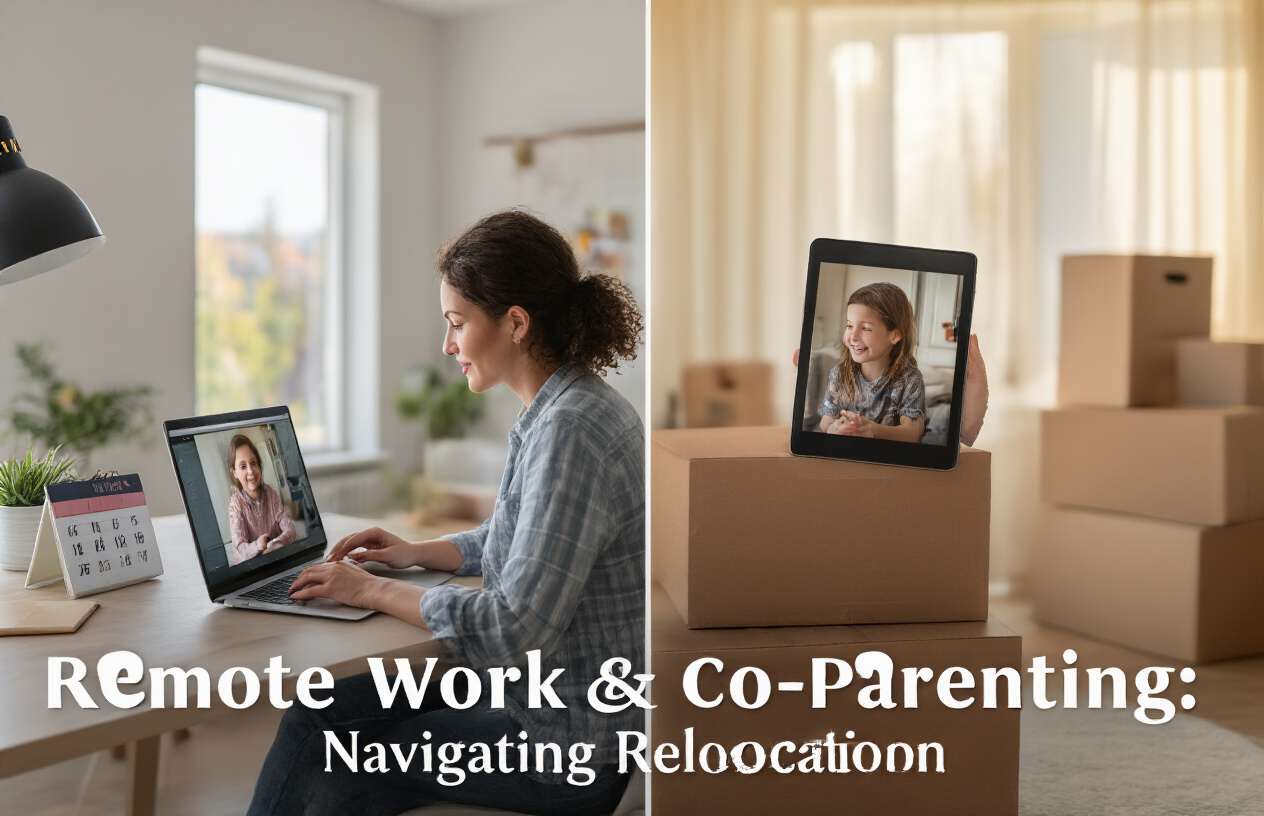
Move‑Away Cases 2025: Remote Work, Relocation & Your Parenting Plan
Your ex just dropped the bomb: “I’m moving across the country—and taking the kids.” Your stomach drops. This isn’t some theoretical custody scenario anymore. This is your life, your children, and suddenly everything feels like it’s hanging by a thread.
Move-away cases have always been complicated, but remote work has completely changed the game. Courts are still figuring out how to handle these custody situations when physical location seems less relevant than ever before.
I’ve spent 15 years helping parents navigate move-away cases, and I’m seeing judges approach these differently in 2025 than even two years ago.
The rules are shifting beneath our feet. But here’s what most attorneys won’t tell you until you’ve paid your retainer: the most successful custody outcomes often happen outside the courtroom entirely.
The Evolution of Move-Away Cases in 2025
How Remote Work Has Changed Relocation Disputes
The landscape of move-away cases has transformed dramatically in 2025. Remember when relocating for work meant an automatic custody battle? Not anymore.
Remote work has fundamentally shifted how courts view relocation requests. With 65% of professional jobs now offering remote options, judges are asking different questions: “Why can’t you work remotely instead of moving?” or “If you can work from anywhere, why not stay closer to the other parent?”
This cuts both ways—parents seeking to relocate face stricter scrutiny if their job could be done remotely. Meanwhile, non-custodial parents have fewer grounds to object when virtual parenting time supplements in-person visits.
Courts are increasingly creative, approving hybrid arrangements where children spend school years with one parent and summers with the other, complemented by daily virtual check-ins.
Key Legal Updates for Parent Relocations
The legal framework has evolved significantly this year. Most states have updated their relocation statutes to explicitly ddress remote work cconsiderations
The burden of proof has shifted, too. Previously, the relocating parent typically carried the burden. Now, courts often require both parents to demonstrate how their proposed arrangement serves the child’s best interests in this digital age.
Notice requirements have changed as well. Many jurisdictions now require:
- 90-day minimum notice (up from 60 days)
- Detailed remote work accommodation plans
- Technology access proposals for virtual parenting time
The New “Substantial Change” Standard
Courts have raised the bar on what constitutes a “substantial change in circumstances” warranting custody modifications. A parent’s desire to relocate for a job that could be performed remotely is no longer sufficient.
The new standard typically requires showing:
- The relocation genuinely benefits the child (not just the parent)
- Remote work alternatives have been exhausted
- A comprehensive plan for maintaining the child’s relationship with both parents exists
Judges increasingly expect parents to have explored flexible work arrangements before filing relocation requests. In one landmark 2024 case, a court denied a mother’s move-away request specifically because her employer confirmed she could perform her job remotely.
Technology’s Impact on Long-Distance Parenting
Technology has revolutionized how courts view the distance between co-parents. Virtual reality co-parenting spaces, now admissible as evidence in court, allow judges to see how parents interact in digital environments.
AI-powered co-parenting platforms now track communication patterns, highlighting cooperation or conflict. These analytics increasingly influence custody decisions.
Courts routinely order specific technology provisions:
- Mandatory daily VR dinner sessions
- Shared access to school portals and medical records
- Smart home systems that maintain consistent routines across households
- Digital milestone sharing requirements
While technology facilitates connection, courts acknowledge its limitations. The “digital relationship supplement” doctrine recognizes that virtual contact enhances but cannot replace physical presence. This balance shapes modern custody arrangements in ways unimaginable just a few years ago.
Understanding Your Legal Rights in Move-Away Cases
A. When Custodial Parents Want to Relocate
The reality of move-away cases hits differently in 2025. If you’re the custodial parent wanting to relocate with your child, you have rights, but they come with responsibilities.
You don’t automatically get the green light to pack up and leave. The courts now recognize your right to pursue career opportunities and personal relationships, especially with remote work becoming standard. But you’ll need to prove the move benefits your child, not just you.
Remember this: Your existing custody order matters tremendously. If you have sole physical custody, courts generally presume you can relocate unless it would harm your child. With joint physical custody? The bar is higher—you’ll need to demonstrate why uprooting your child serves their best interests.
Before you start browsing homes in another state, know that transparency is non-negotiable. Blindsiding your co-parent with relocation plans is the fastest way to end up in a contested court battle.
B. Non-Custodial Parent’s Options to Contest
Got that dreaded notice that our ex wants to move away with your kid? Don’t panic—you’ve got options.
First things first: You can formally object by filing a motion to prevent relocation. The clock is ticking, though—courts in 2025 have streamlined timelines for these cases.
Your strongest argument? Proving the move would harm your relationship with your child. Courts take this seriously now, especially with research showing children benefit from maintaining bonds with both parents.
You can propose alternatives too:
- Requesting modification of the current custody arrangement
- Suggesting a long-distance parenting plan with extended vacation time
- Proposing relocation yourself to the same area
The digital co-parenting revolution gives you more ammunition. If your ex claims you can “just FaceTime,” courts now recognize virtual contact isn’t equivalent to physical presence—it’s a supplement, not a replacement.
C. The Court’s Primary Considerations in 2025
Courts in 2025 have evolved their approach to move-away cases, focusing on these key factors:
- Child’s stability and continuity – Will the move disrupt the child’s education, friendships, and community connections?
- Quality of both parent-child relationships – Courts examine not just the quantity of time spent, but the meaningful involvement each parent has.
- Remote work flexibility – This is huge now. If either parent works remotely, courts consider how this impacts the necessity of relocation.
- Digital co-parenting capabilities – Can technology effectively maintain the non-custodial relationship? Courts now evaluate each family’s tech literacy.
- Child’s preference – For older children, their input carries more weight than ever, with courts employing child specialists to evaluate authentic preferences.
The “tender years doctrine” that favored mothers with young children? Nearly extinct by 2025. Instead, courts prioritize which parent better fosters the child’s relationship with the other parent—the “friendly parent” factor now weighs heavily.
D. Documentation Requirements for Relocation Requests
Thinking about moving with your kids? The paperwork requirements in 2025 are no joke.
You’ll need to submit a comprehensive relocation plan covering:
- Detailed information about the new home and neighborhood
- Educational opportunities in the new location
- Healthcare availability and continuity plans
- Proposed visitation schedule with specific dates, times, and transportation arrangements
- Cost-sharing proposal for travel expenses
- Virtual visitation schedule (video calls, online activities)
Courts now require evidence of your research into these factors—screenshots of school ratings, housing listings, and job offers are insufficient. You need thorough documentation.
The game-changer in 2025? The digital parenting portfolio. Most courts now require you to demonstrate your technological preparedness for long-distance co-parenting, including familiarity with co-parenting apps and digital communication tools.
Pro tip: Include contingency plans addressing potential challenges. Courts favor parents who think ahead about maintaining the other parent’s relationship despite distance.
E. Timelines and Notification Requirements
The days of surprising your co-parent with moving plans are long gone. In 2025, notification requirements have teeth.
Most states now require:
- Written notice 60-90 days before any proposed move
- Certified mail delivery with return receipt
- Specific details about the new location, the reason for the move, and the proposed new parenting schedule
Miss these deadlines? Courts can temporarily block your move or even transfer custody to the other parent.
The response window matters too. Non-custodial parents typically have 30 days to formally object after receiving notification. Don’t file on time? You might forfeit your right to contest.
Emergency relocations still exist for domestic violence or immediate job transfers, but the bar is higher than ever. You’ll need documented evidence of the emergency nature of your move.
Courts now fast-track move-away cases, with many jurisdictions guaranteeing hearings within 45 days of objection filing. This prevents the moving parent from creating a “status quo” by relocating before court intervention.
Remote Work Considerations in Custody Arrangements
A. Leveraging Remote Work for Flexible Custody Solutions
Remote work has completely changed the game for parents navigating custody arrangements. When you’re not tied to a physical office, you suddenly have options that weren’t on the table before.
Picture this: instead of rigid weekend-only visits, you can structure your work week around your parenting time. Maybe you take Wednesdays and Thursdays to work from your co-parent’s city, giving you midweek time with your kids without disrupting their school schedule.
Parents are getting creative. Some are doing “work vacations” where they spend extended periods in their children’s location, working during school hours and being present for afternoons and evenings. Courts are increasingly receptive to these arrangements because they see the benefit for the children.
The key is documentation. Keep records of:
- Your remote work agreement
- Flexible hours policy
- Performance reviews showing that you can work effectively remotely
- Examples of successful work during previous custody visits
B. When Remote Work Strengthens Your Relocation Case
The days of “you can’t move because of your job” are fading fast. If you’re seeking to relocate with your children, remote work can be your strongest argument.
Remote work directly addresses the court’s primary concern: stability. When you can bring your job with you, you’re demonstrating continued financial security despite geographic changes. That’s huge.
Courts particularly favor relocation cases where:
- Your remote position is permanent (not just pandemic-related)
- You’ve already established a track record of remote productivity
- The new location offers additional benefits (family support, better schools, lower cost of living)
- Your income will remain stable or increase
One parent recently won their relocation case specifically because they could demonstrate two years of successful remote work performance, eliminating the financial risk concerns.
C. Demonstrating Job Stability in a Remote Environment
Courts still worry about the permanence of remote arrangements. The question isn’t just “Can you work remotely now?” but “Will you still have this flexibility in two years?”
Proving stability means gathering concrete evidence:
- A formal remote work policy from your employer
- Written confirmation that your position will remain remote long-term
- Salary history showing stable or increasing income while remote
- Performance metrics demonstrating productivity
- Testimonials from supervisors about your remote work effectiveness
The most successful cases include statements from employers confirming your remote arrangement isn’t just tolerated—it’s endorsed. If your company has moved to a “remote-first” model, get that in writing.
Remote work stability looks different for entrepreneurs and freelancers. If that’s you, prepare documentation showing consistent client relationships, recurring revenue, and tax returns demonstrating stable income patterns over multiple years.
Creating a Relocation-Resilient Parenting Plan
Essential Components of Modern Parenting Plans
Divorce is hard enough without worrying about what happens when someone needs to move. That’s why forward-thinking parenting plans now address relocation possibilities upfront.
The best modern parenting plans include:
- Clear decision-making protocols for potential relocations
- Distance thresholds that trigger plan modifications (50 miles? 100 miles? Different state?)
- Right of first refusal provisions that work regardless of location
- Communication schedules that flex based on distance
- Holiday and vacation scheduling with travel considerations built in
Don’t just focus on your current situation. The parenting plan you create today needs to work in three, five, or ten years when circumstances inevitably change.
Building Flexibility for Future Career Changes
Remote work has blown the doors off traditional custody arrangements. Your parenting plan should breathe and grow with your career.
Innovative flexibility measures include:
- Graduated visitation schedules that shift as distance increases
- Built-in renegotiation timelines (every 2-3 years)
- Career opportunity clauses that allow for temporary schedule adjustments
- Provisions for trial relocations before permanent moves
Remember this: the more flexible your plan, the less likely you’ll end up back in court fighting expensive modification battles when someone gets a job offer they can’t refuse.
Technology Integration Clauses
Video calls aren’t just a pandemic thing anymore—they’re essential co-parenting tools when distance is involved.
Your parenting plan should specify:
- Required technology platforms for virtual visitation
- Minimum frequency and duration of video calls
- Who provides and maintains devices for the child
- Protocols for missed connections and technical difficulties
- Rules about recording virtual visits
Tech changes fast, so avoid naming specific apps. Instead, focus on the function (“video calling platform”) rather than the brand.
Transportation and Logistics Planning
Who pays for plane tickets can become a bitter fight without clear guidelines. Address the nitty-gritty details now.
Solid logistics planning includes:
- Transportation cost allocation (percentage split, alternating responsibility?)
- Preferred travel methods at various distances
- Pickup/dropoff procedures for long-distance exchanges
- Travel companion requirements for young children
- Emergency protocols during transit
The parent who moves doesn’t always bear all transportation costs—many modern arrangements use income-proportional splits to keep things fair while ensuring regular contact remains financially sustainable for both households.
Technology Tools for Successful Co-Parenting at a Distance
Virtual Visitation Platforms and Best Practices
Co-parenting from different cities isn’t just about phone calls anymore. Virtual visitation has evolved dramatically, and courts now recognize its importance in maintaining parent-child bonds.
Zoom and FaceTime remain popular choices, but platforms like Caribu now offer interactive elements where you can read bedtime stories together or play games during your calls. The magic happens when these calls become routine rather than sporadic events.
A good rule of thumb? Schedule these virtual visits just like you would in-person time. Kids thrive on predictability. When my client Maria moved to Seattle for work, she set up “Tuesday Taco Night” virtual dinners with her daughter – they prep the same meal and eat together online.
Some practical tips that judges love to see:
- Keep backgrounds quiet and distraction-free
- Use earbuds for better sound quality
- Have a backup platform ready if technology fails
- For younger kids, keep sessions shorter (15-20 minutes)
- Record sessions only with mutual consent
Co-Parenting Apps That Strengthen Your Case
The days of “he-said, she-said” disputes are over. Smart parents are using specialized apps that create immutable records of all communications and agreements.
OurFamilyWizard leads the pack as the gold standard in family courts nationwide. It tracks messages, expenses, and schedule changes – all admissible in court. One judge told me recently, “When parents show me OurFamilyWizard logs, I know they’re serious about co-parenting.”
AppClose offers similar features with a free basic version, making it accessible to everyone regardless of their financial situation.
What makes these apps powerful for move-away cases:
- Timestamp verification on all communications
- Expense tracking with receipt uploads
- Shared calendars that notify when events are viewed
- Tone meters that flag potentially inflammatory language
- Request features that document when the other parent confirms
Digital Documentation for Court Compliance
Documentation isn’t just helpful – it’s essential when you’re parenting across state lines. But random screenshots and email chains won’t cut it anymore.
Courts now expect organized digital records that demonstrate consistent communication and involvement. Cloud storage solutions like Google Drive or Dropbox with shared folders for school records, medical information, and activity schedules demonstrate your commitment to transparency.
Smart parents create digital portfolios containing:
- Educational records and extracurricular activities
- Medical appointment summaries
- Extra-curricular activity schedules and achievements
- Travel itineraries for custody exchanges
- Photos of special events you’ve participated in remotely
Pro tip: Create a simple spreadsheet tracking all virtual visits, including date, duration, and activities. This becomes proof of your continued presence despite the distance.
Setting Boundaries for Digital Communication
Technology is a double-edged sword in co-parenting. While it enables connection, it can also create expectation overload without clear boundaries.
The most successful long-distance co-parents establish explicit guidelines around digital communication. This isn’t just good practice – it demonstrates maturity to family courts.
Effective boundary-setting includes:
- Designated “emergency” channels versus routine communications
- Reasonable response timeframes (24 hours for non-urgent matters)
- Privacy protocols (no recording calls without consent)
- Respectful communication hours (no texts after 9 pm unless urgent)
- Social media posting agreements regarding children
Remember that judges review how you communicate. One client lost significant ground in her case when she repeatedly sent late-night accusatory texts to her ex. Digital footprints are forever, especially in custody cases.
Financial Considerations in Move-Away Cases
A. Travel Cost Allocation Strategies
When parents live far apart, travel expenses can add up fast. Most judges want to see a fair split of these costs in your parenting plan. But what’s “fair” isn’t always 50/50.
Courts typically look at:
- Each parent’s income
- Who initiated the move
- Distance between homes
- Frequency of visits
Some creative approaches that work in 2025:
- Proportional division based on income (higher earner pays more)
- The relocating parent covers airfare while the stay-behind parent handles local expenses
- Using travel points/miles programs strategically
- Setting up a joint travel fund with monthly contributions
Don’t forget to specify who is responsible for booking the travel. This might seem minor until you’re arguing about $200 price differences or convenient flight times.
B. Cost of Living Adjustments to Support
Moving from Tulsa to San Francisco? The exact dollar amount won’t stretch nearly as far.
Smart parents are now building COL adjustments right into their agreements. This is especially crucial in 2025’s volatile economy.
Some approaches:
- Tying support amounts tothe official cost of living indices
- Automatic recalculation when the difference exceeds a certain percentage
- Regional economic comparison tools
- Using online calculators that factor in housing, food, and childcare costs
The courts are increasingly receptive to these adjustments, recognizing that $1,000 means something very different depending on where you live.
C. Tax Implications of Relocation
The tax hit from relocation can blindside unprepared parents. Different states have wildly different tax structures that affect your bottom line.
Key tax considerations:
- Who claims the child as a dependent (some parents now alternate years)
- State income tax differences
- Child tax credit allocation
- Tax treatment of support payments
Remote workers face particularly complex situations when they, their employer, and their co-parent are all in different states. Some parents now consult tax professionals during mediation to avoid nasty surprises.
Remember that the IRS doesn’t care what your custody agreement says if it doesn’t align with their rules about who qualifies to claim a child.
D. Handling Educational Expenses Across Jurisdictions
Educational costs vary dramatically between regions, creating thorny issues in move-away cases.
Public school in one area might be excellent, while the other parent’s location might necessitate a private school. Some jurisdictions require parents to share private school costs; others consider it discretionary.
Smart solutions include:
- Education savings accounts with joint oversight
- Detailed agreements about college expense sharing
- Virtual schooling options that maintain educational continuity
- Proportional responsibility based on local educational quality
Many courts now require comprehensive extracurricular plans that address everything from extracurricular activities to college savings, particularly in areas with significant differences in educational quality between parents’ locations.
Navigating move-away cases in 2025 requires understanding how remote work has transformed the legal landscape surrounding relocation and custody arrangements. Parents must be aware of their legal rights, including notification requirements and the court’s evaluation criteria when considering relocation requests. Creating flexible, technology-enhanced parenting plans that prioritize children’s needs while accommodating career opportunities is essential in today’s mobile society.
As you consider potential relocation, focus on developing a comprehensive parenting plan that incorporates virtual visitation tools, clear communication protocols, and fair financial arrangements to support your children regardless of distance. Remember that courts ultimately seek solutions that serve children’s best interests—approach negotiations with this principle in mind, and consult with an experienced family law attorney to navigate your specific situation successfully.
At Lass Law, our Divorce & Family Law Attorneys in North County San Diego bring clarity and strength to challenging situations. Whether you’re seeking counsel from a Family Law Attorney in Encinitas, pursuing guidance under Divorce Law, or working with a Family Law Attorney in San Marcos, our team is committed to protecting what matters most. Explore our full range of Family Law services for trusted advocacy.










